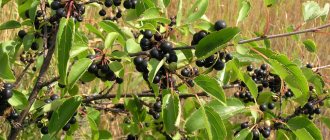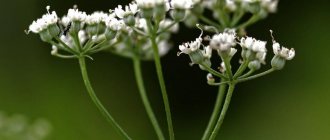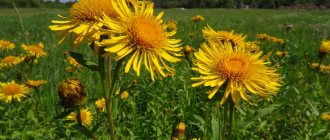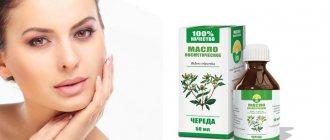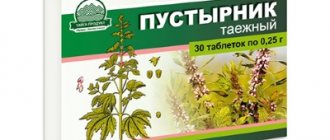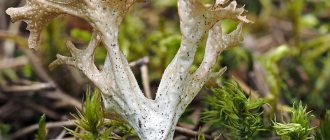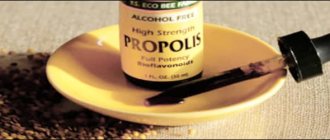Collected in August–September during the phase of fruit ripening and dried leafy shoots of the current year of the wild evergreen shrub bog rosemary – Ledum palustre L., family. heather – Ericaceae.
MINISTRY OF HEALTH OF THE RUSSIAN FEDERATION
PHARMACOPOEIAL ARTICLE
Ledum marsh shoots FS
Ledi palustris cormus Instead of Global Fund XI , no. 2, art. 1
Collected in August–September during the phase of fruit ripening and dried leafy shoots of the current year of the wild evergreen shrub bog rosemary – Ledum palustre L., family. heather – Ericaceae.
general information
The marsh rosemary belongs to the Heather family.
The genus Ledum includes 6 species of plants. Ledum grass prefers acidic soil. Grows in moss swamps, peat bogs and swampy coniferous forests. In the place where wild rosemary grows, as a rule, there is a deep layer of peat. Can form large thickets. Distribution area: Europe, Asia and North America.
For the first time, wild rosemary was introduced into European medical practice by Swedish doctors. The medicinal properties of this plant were described in 1775 by Carl Linnaeus.
Procurement of raw materials
Marsh wild rosemary blooms in early summer, emitting a strong, specific odor. Abundant flowering indicates that you can start harvesting shoots. This can be done after the fruits are fully ripened - at the end of August. Young shoots need to be cut off along with flowers and leaves. To dry, they are laid out on paper under a canopy or tied into small bundles and hung there. If artificial drying is used, the temperature should not exceed 40°C. The smell of dried wild rosemary herb is resinous. It can cause headaches, dizziness, and can cause fainting. Therefore, it is undesirable for them to breathe.
After drying of wild rosemary shoots is completed, they are packaged in paper bags. Ledum herb should be stored in a separate place, avoiding contact with other herbs. It can be toxic if you do not follow the rules for its storage and dosage when using it.
Video
This video will tell you about the medicinal properties of wild rosemary.
Ledum is popular among practicing herbalists and homeopaths. Official medicine also paid attention to it. And it's deserved. It helps to quickly cope with a dry cough, cure a lingering cough, and relieve a painful cough. But wild rosemary can cause poisoning if used uncontrollably. Store dried wild rosemary herb correctly, always prepare a fresh infusion and, most importantly, do not exceed the dosage. Then this gift of nature will help you quickly overcome your cough. Treatment of dry cough in children with folk remedies is described here.
Medicinal properties
Traditional medicine knows various medicinal forms of wild rosemary: decoctions, alcohol infusions, oils, ointments.
The herb marsh rosemary is used in medicine primarily due to its expectorant effect and antimicrobial properties for bronchitis, tracheitis, pneumonia, whooping cough and tuberculosis . Ledum marsh irritates the mucous membranes, increasing the secretion of bronchial secretions.
The antiseptic properties of wild rosemary will help during a flu epidemic. To do this, use its decoction as an antiviral agent, drop oil into the nose (you can use a decoction) or sniff the powder of the dry plant, fumigate the premises for disinfection. Ledum herb helps well with inflammation of the nasal mucosa: the oil (or decoction) is instilled into the nose a few drops. In case of a cold, wild rosemary will have a diaphoretic effect.
Thanks to its anti-allergic properties, wild rosemary will help cope with respiratory problems.
Ledum preparations help people with coronary heart disease. Drinking the decoction improves blood circulation and normalizes blood pressure. It is also recommended to take a decoction of wild rosemary shoots for the formation of kidney stones.
An infusion of wild rosemary shoots is used for inflammation of the small and large intestines , as it acts as a bactericidal agent.
Medicine is also aware of the wound-healing properties of wild rosemary shoots. An alcohol tincture is made from the young shoots or a decoction is prepared that treats various skin injuries: abrasions, cuts, frostbitten areas, etc. The alcohol infusion is used for rubbing during hypothermia, avoiding the heart area.
An infusion of wild rosemary shoots helps with joint diseases and has an analgesic effect for various injuries and bruises. For such diseases, various ointments and oils based on wild rosemary will help; they are also recommended for people who suffer from rheumatism or radiculitis.
Since the infusion of wild rosemary shoots has an antiseptic effect, it is used to treat problem areas of the skin. This infusion is used to wipe boils and lichens.
Despite the sufficient range of medicinal effects of wild rosemary herb, one must remember that this plant is poisonous. Therefore, in case of dizziness, increased irritability, problems with the intestines or stomach, you should immediately stop using the drugs.
How to brew
High-quality raw materials are used for treatment. It must be dry (have humidity up to 14%). Ledum should be collected during flowering and contain:
- stems – up to 20%;
- of which, branches older than one year – no more than 10%;
- organic additives and impurities – less than 1%.
Inflammation of the respiratory tract is treated with wild rosemary, using it in the form of aqueous infusions or decoctions. To do this, take dry raw materials, dried in the shade, grind them and brew them. You can combine wild rosemary with other herbs.
Hot infusion
- Pour a teaspoon of dry leaves and branches of flowering wild rosemary into 0.5 liters of boiling water. This should be done in a hermetically sealed container, for example, a thermos.
- Wrap the container with the medicine and leave for half an hour.
- Take 1/2 cup warmed up during ARVI after meals, after separating the cake.
- Sweet lovers can sweeten the infusion with a spoon of natural honey.
- Consumed warm, this infusion helps remove phlegm and acts as a diaphoretic.
Ledum has a mild hypnotic effect.
Use of wild rosemary in medicine
Ledum is used as an expectorant and anti-inflammatory agent for various respiratory diseases and bronchopulmonary diseases. It is used in the treatment of bronchitis and tracheitis - conditions that are characterized by the presence of difficult to separate sputum. Due to the ability to dilute sputum, wild rosemary shoots facilitate its removal and improve the general condition of the patient. Plant preparations have a bronchodilator effect. The listed set of effects from the use of wild rosemary shoots makes them useful for pneumonia, whooping cough, laryngitis, pulmonary tuberculosis, bronchopneumonia, and bronchial asthma. The plant helps eliminate severe coughs and has an antiseptic and sedative effect.
The antimicrobial properties of wild rosemary ensure the effectiveness of its external use for various skin diseases - dermatitis, eczema. The plant helps protect wounds from infection, improves blood circulation in damaged areas of the skin, provides antioxidant effects and accelerates regeneration. Preparing decoctions and lotions for external use is useful not only for treating wounds from microbes. Ledum preparations have a moderate analgesic effect. For dermatological diseases, the plant is used not only externally, but also internally in the form of decoctions and infusions.
Plant preparations have a stimulating effect on the nervous system. They have antihypertensive properties, so they are sometimes used in the treatment of mild forms of hypertension. Ledum is a diuretic and has an antispasmodic effect on smooth muscles.
Benefits of wild rosemary
Due to the combination of their beneficial properties, wild rosemary shoots are used in the treatment of arthritis. They are taken orally in the form of decoctions, and also rubbed into the affected joints. The same scheme is used to treat gout with wild rosemary.
The plant contains glycosides, flavonoids, vitamins, and organic acids. One of the main active ingredients of wild rosemary is its essential oil, which combines cymol, ledol, palustrol, and bicyclic alcohol. The percentage of these substances varies depending on the region where wild rosemary grows. Due to its rich chemical composition, the plant has a wide range of effects on the body. Ledum essential oil irritates the mucous membranes, causing the production of sputum and its elimination. At the same time, the substance has an anticonvulsant and analgesic effect, improves blood circulation, and dilates blood vessels. Ledum's properties include a blood purifying effect on the body. In moderate quantities, the plant can have a tonic or, conversely, a sedative effect. It is worth considering that wild rosemary should be used with caution by those people who have low blood pressure.
Due to its bactericidal and tonic properties, wild rosemary was used in folk medicine as a prophylactic against colds. It is used externally for insect bites, bruises, puncture wounds, and lacerations. Lotions and compresses increase blood circulation, so they are also used for numbness of fingers and frostbite. Along with its medicinal properties, the plant has an insecticidal effect - fumigating a room with it kills fleas, bedbugs and moths. During this procedure, it is necessary to protect the respiratory organs and mucous membranes.
Chemical composition
With the exception of the roots, all parts of wild rosemary contain essential oil. It determines the strong smell of the plant. Essential oil has a strong bactericidal effect, destructive for staphylococci, dysentery bacillus and other pathogenic microorganisms.
Tannins, pectin, resin, bitterness, wild rosemary-tannic acid, dyes and ascorbic acid were found in the leaves.
The liquid part is isolated from the essential oil, which is called eleopten.
Contraindications for taking wild rosemary
Since wild rosemary is a poisonous plant, it should be taken in accordance with the recommendations of a doctor. Self-medication with preparations of this herb is not allowed, as it is dangerous to health. In case of wild rosemary poisoning, severe headache, nausea, dizziness, increased excitability of the nervous system, and in severe cases, depression can develop. Plant pickers are a special risk group - if they spend a long time in wild rosemary thickets, symptoms of poisoning may appear. Intoxication also occurs when inhaling the essential oil of the plant when collecting or drying raw materials, or walking along places where wild rosemary blooms.
Wild rosemary shoots should not be used by children under 18 years of age, people with allergies to the plant, or pregnant or breastfeeding women. Drivers and people who need to maintain reaction speed and intense attention should not use medications based on them. Ledum should not be taken in combination with other antitussive drugs and herbal preparations. At the first signs of increased hyperexcitability or deterioration of the nervous system, taking wild rosemary medications should be stopped immediately. Dizziness is also an undesirable symptom.
Based on materials:
1. Maznev N.I. Golden Book of Medicinal Plants / N.I. Maznev. — 15th ed., add. — M.: LLC “ID RIPOL Classic”, LLC Publishing House “DOM. XXI century", 2008. - 621 p. 2. Maznev N.I. Herbalist / N.I. Maznev. - M.: Gamma Press 2000 LLC, 2001. - 512 p. from illus. 3. Tovstukha E. S. Phytotherapy / E. S. Tovstukha. - K.: Health, 1990. - 304 p., ill., 6.55 arc. il. 4. Chukhno T. Great encyclopedia of medicinal plants / T. Chukhno. - M.: Eksmo, 2007. - 1024 p. The information is provided for informational purposes and should not be used for self-medication.
Determination of the main groups of biologically active substances
- Thin layer chromatography
Preparation of solutions
Standard solution (RS) of thymol and menthol. 5 mg of thymol and 10 mg of menthol are dissolved in 10 ml of 96% alcohol with stirring. The shelf life of the solution is no more than 3 months when stored in a cool, dark place.
Test solution. To 20 μl of oil obtained during quantitative determination, 1 ml of toluene is added.
On the starting line of a high-performance chromatography plate with a layer of silica gel on an aluminum substrate measuring 10 × 10 cm, 15 μl of the test solution and 20 μl of a solution of CO thymol and menthol are applied in strips. The plate with the applied samples is dried at room temperature, placed in a chamber with a solvent mixture of ethyl acetate - toluene (5:95), and chromatographed using an ascending method. When the front of solvents passes about 80–90% of the length of the plate from the starting line, it is removed from the chamber, dried until traces of solvents are removed, treated with anisaldehyde with alcoholic sulfate solution, kept at a temperature of 100–105 °C for 5–10 minutes and viewed in daylight.
The chromatogram of a solution of CO thymol and menthol should reveal a blue adsorption zone (menthol) in the lower part and above it a pink adsorption zone (thymol).
The chromatogram of the test solution should show: an adsorption zone from violet to reddish-violet color slightly above the level of the menthol adsorption zone on the chromatogram of a solution of CO thymol and menthol (ice), as well as a violet to reddish-violet color zone slightly above the thymol adsorption zone on the chromatogram solution of CO thymol and menthol (palustrol); detection of other adsorption zones is allowed.
- 2. About 2.0 g of crushed raw material, passing through a sieve with 2 mm holes, is placed in a 100 ml flask, 20 ml of 70% alcohol is added and heated in a water bath with reflux for 10 minutes. The extract is then cooled and filtered (test solution).
A) 1 ml of the test solution is placed in a test tube, zinc powder and 5–7 drops of concentrated hydrochloric acid are added and mixed; a slight pink color should be observed, which becomes more intense when heated (flavonoids)
B) To 1 ml of the test solution add 2 drops of iron(III) ammonium sulfate solution; A black-green color (tannins) should be observed.
